It’s fascinating how one man’s trash can be another’s treasure. This saying encapsulates the value of a 1962 half dollar, a coin that was once underappreciated but has now become a highly coveted rarity.
Notably, the 1962 half dollar has even greater value when compared to its counterparts from the series minted between 1942 and 1963, with most of them having lower mint numbers.
In this guide, we shall examine the various factors that determine the value of an individual 1962 half dollar coin. We’ll also offer insights on how to capitalize on it. Let’s dig in.
1962 Half Dollar Price Chart and Overview
The value of a 1962 half dollar depends on its condition and any mint errors. But, before we get into the intricate details, here’s a breakdown of the current market value of a 1962 half dollar coin without any error:
| Coin and mint mark | Good (G4) | Fine (F12) | Extremely fine (XF40) | Uncirculated (MS60) | Brilliant Uncirculated (MS65) | MS66+ |
| 1962 | $9.25 | $9.25 | $9.75 | $16 | $225 | $1900 |
| 1962 FBL | – | – | – | $20 | $1750 | $9750 |
| 1962-D | $9.25 | $9.25 | $9.75 | $16.50 | $95 | $1130 |
| 1962-D FBL | – | – | – | $25 | $550 | $4000 |
At the Denver mint (“D” mint mark), an astounding 35,473,281 business strike half dollar coins were produced. Conversely, the Philadelphia Mint (no mint mark) minted 12,932,019 coins, among which 3,218,019 were proof coins.
A Franklin half dollar has a total silver weight of 0.36169 oz. pure silver. This material gives the 1962 half dollar a base value that’s significantly higher than face value.
A coin’s melt value depends on its silver content, calculated by multiplying the silver weight by the current silver spot price.
The spot price was $24.01 per troy ouncein August 2023. So, this coin holds a melt value of at least $8.68 (0.36139 × 24.01). This price is purely about the metal and doesn’t consider collector’s worth, rarity, or coin condition.
The spot price was $24.01 per troy ounce in August 2023. So, this coin holds a melt value of at least $8.68 (0.36169 × 24.01).
Interestingly, the presence of a mint mark, such as the “1962-D” for the Denver Mint, does not always guarantee higher or lower values in lower grades.
However, values in the mint state category vary greatly, favoring 1962 50c coins from the Denver mint.
Among 1962 half dollars, the most valuable are those in mint state (MS), showcasing Full Bell Lines (FBL). The latter is a meticulous detail on the coin, where you can see and count all the strokes on the top and bottom of the Liberty Bell depicted on the coin’s reverse side.
Fascinating History of the 1962 Half Dollar

Coin collecting started to become popular in the ‘60s. However, collectors did not pay much attention to the 1962 half dollar.
At the time, you could buy two gallons of gasoline for 50 cents. So, why would you spend that money stocking up on a single coin when others beckoned with greater potential premiums?
On top of that, despite the later appreciation for the 1962 half dollar, its initial release had high mintage numbers, which did not immediately excite collectors.
To add insult to injury, a significant portion of these coins were turned into bullion. The price of silver plummeted on March 27, 1980, otherwise known as “Silver Thursday.” From 1979, this precious metal had soared in value by an astonishing 700% within 12 months.
The 1962 50c now stands tall, surpassing the value of almost all other Franklin half dollars in the series with lower mintage numbers. It had the last laugh.
Fortunately, you can still get many of these 1962 half dollars in mint condition thanks to the foresight of collectors who recognized their hidden worth and safeguarded them under lock and key.
1962 Half Dollar Physical Features
The 1962 half dollar coin exudes a brilliant luster thanks to its 90% silver and 10% copper composition. Over time, these coins may get a white tarnish as the materials react to air and moisture in their surroundings.
Here are further details about the physical characteristics of a 1962 50C coin:
- Diameter: 30.6 mm
- Thickness: 2.15 mm
- Weight: 12.5 grams
- Edge: Reeded, plain rim
Obverse and Reverse Design
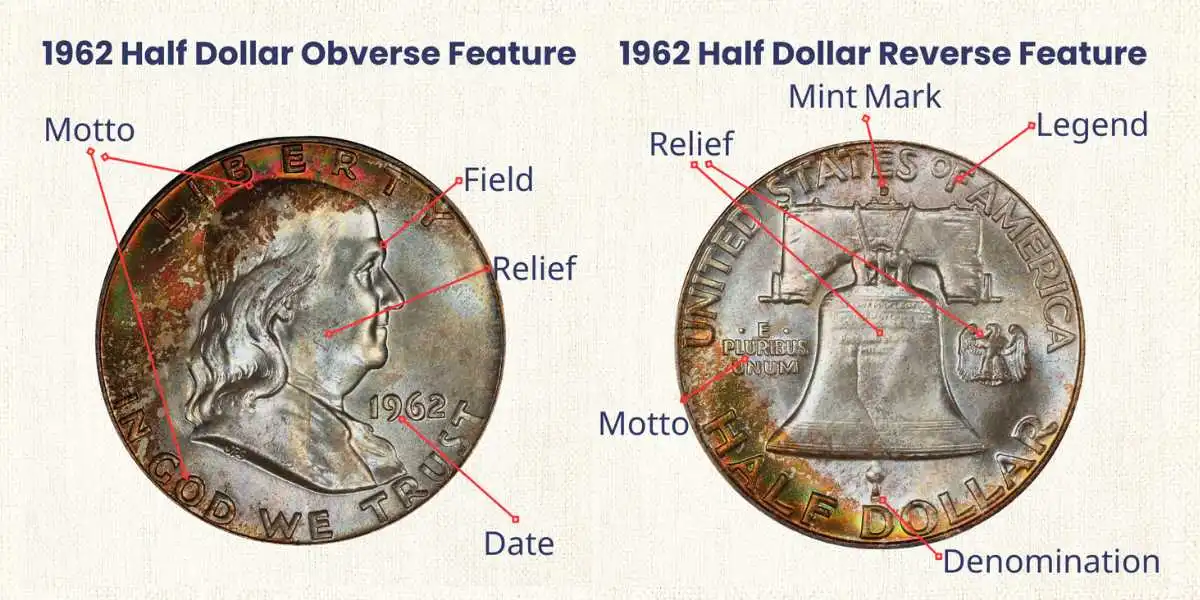
1962 50c coins don’t deviate much from other Franklin half dollars that have the following features:
- Obverse (Front): A right-facing Benjamin Franklin, words “LIBERTY” above, “IN GOD WE TRUST” below, and the year “1962” to the right of the bust.
- Reverse (Back): A cracked Liberty Bell with “E PLURIBUS UNUM” to the left, an eagle to its right, “HALF DOLLAR” below, and “UNITED STATES OF AMERICA” encircling the top. If from the Denver mint, a Distinctive D appears on top of the bell.
1962 Half Dollar Varieties and Valuation
Here, we’ll break down the values of the different types of 1962 half dollars, paying close attention to coins in the mint state categories. Let’s begin.
1962 Half Dollar Value
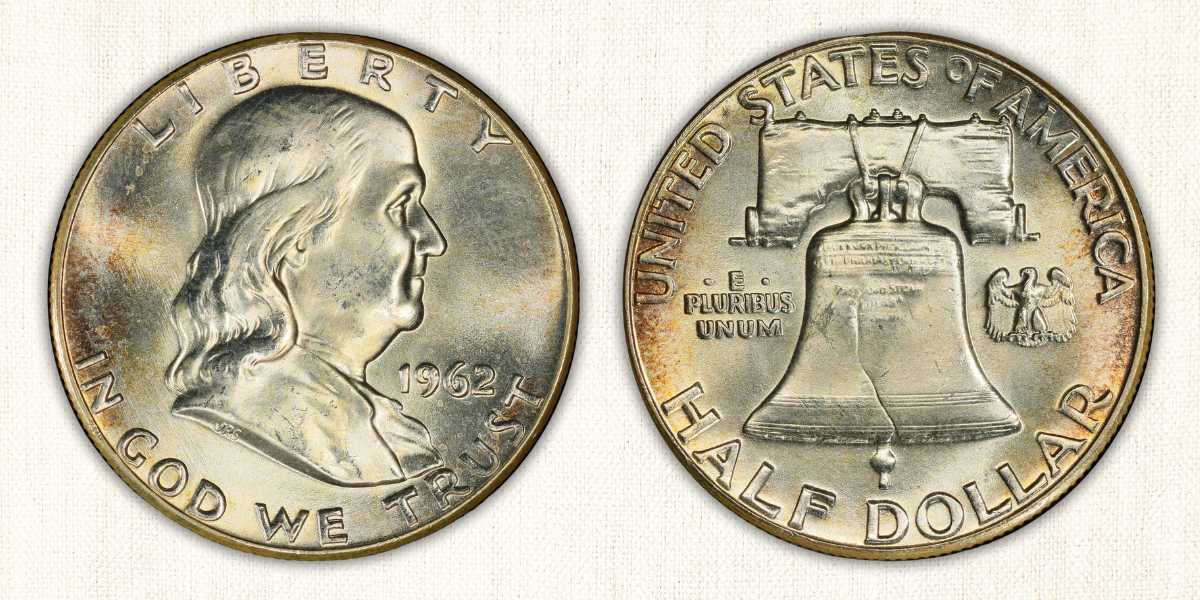
Given the comparatively lower mintage numbers from Philadelphia, one might naturally assume that they are rarer and, consequently, more valuable. This assumption holds true when considering the historical sales record.
In July 2004, a 1962 50c coin with FBL went for the record price of $17,825.
On the other hand, the record price for a 1962-D 50c, boasting a similar grading of MS66 with FBL was $9,200, same year and month.
Predicting the precise market price of a 1962 50-cent coin in the highest grade (MS66+) is a task that defies the art of fortune-telling. Its valuation depends upon various factors, including condition, rarity, and market supply.
Take, for instance, in an auction hosted by Legend Rare Coin Auctions, two PCGS MS66FBL graded 1962 Franklin half dollars commanded vastly different prices.
In October 2015, one claimed a princely sum of $9,106. Two years later, a similarly graded coin sold for $4,818.
There’s at least more consensus in lower categories, and here’s a breakdown of the regional prices for 1962 50c coins in pristine condition:
| 1962 50c MS | ||
| Grade | Estimated value | With FBL |
| 60 | $16 | $20 |
| 61 | $20 | $25 |
| 62 | $22 | $33 |
| 63 | $25 | $50 |
| 64 | $33 | $265 |
| 65 | $95 | $1750 |
| 66 | $1050 | $9750 |
1962-D Half Dollar Value
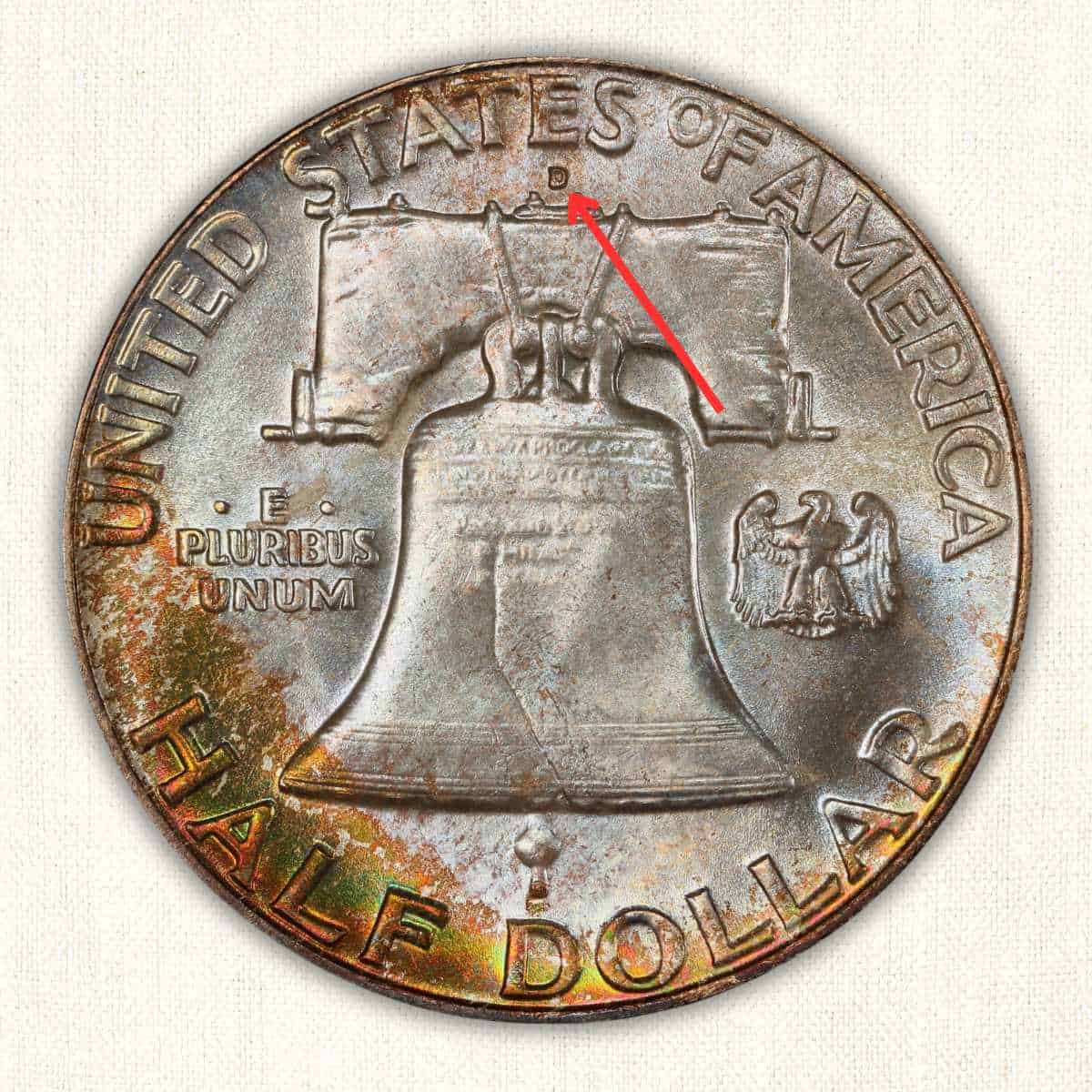
After analysis, we discovered that PCGS-certified 1962-D 50c coins consistently fetched higher prices than their NGC-graded counterparts.
For example, in August 2006, an NGC-graded 1962-D with an MS67 grade fetched $5,750 at Heritage Auctions. Not bad at all. However, it pales in comparison to the record-breaking sale of a similar coin in July 2004, which reached an astounding $9,200.
The latter 1962-D 50c had a slightly ‘lower’ MS66 grade assigned by PCGS. Even more surprising, it was sold at the same auction house two years earlier.
That example merely scratches the surface, as the price of a 1962-D coin can vary depending on market demands, supply, and even the venue of the auction house itself.
To further illustrate the point above, let’s highlight two 1962-D with an MS66FBL classification by PCGS.
In January 2006, one of these coins fetched an impressive $7,475 at a Heritage Auction event. However, fast-forward to July 2016, a similarly graded coin sold for a comparatively modest $3,800 during a Legend Rare Coin Auction sale.
Here’s a breakdown of the values of a 1962 50c in mint state, highlighting its exponential potential:
| 1962-D 50c MS | ||
| Grade | Estimated value | With FBL |
| 60 | $16.5 | $25 |
| 61 | $18 | $26 |
| 62 | $20 | $28 |
| 63 | $22 | $40 |
| 64 | $30 | $75 |
| 65 | $95 | $550 |
| 66 | $1130 | $4000 |
| 67 | $4887–$5750 | – |
1962 Proof Franklin Half Dollar
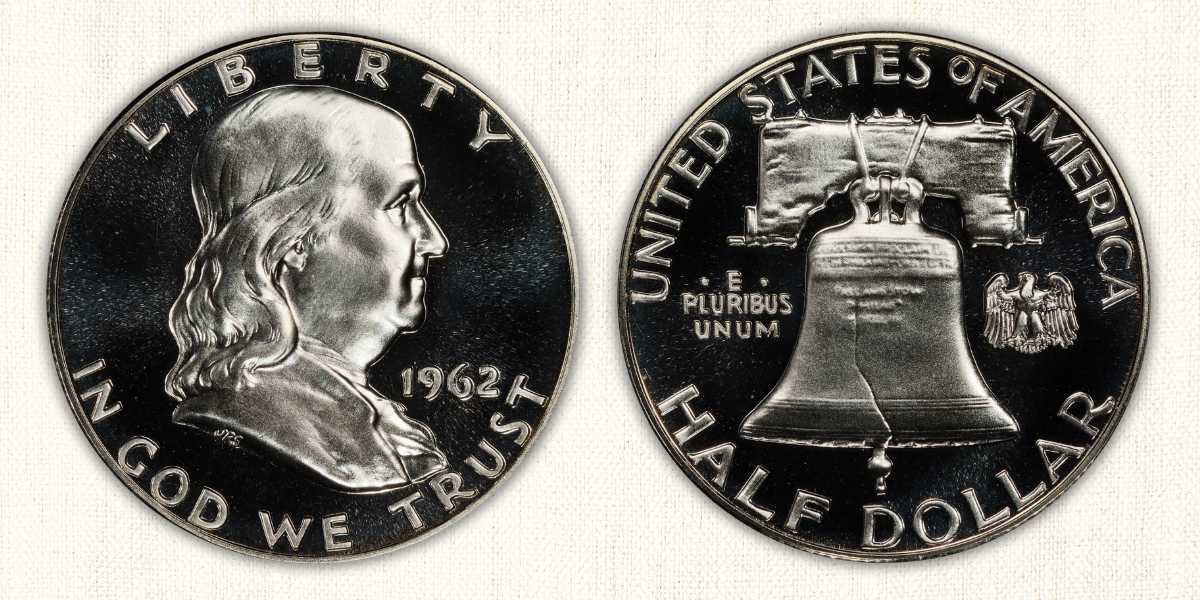
In 1962, the US Mint produced many Franklin half dollar proof coins alongside regular circulation coins to generate extra revenue.
Coin collectors eagerly snapped up the 1962 half dollar proofs when they were first released. More proof half dollars were made that year than in other years of the Franklin half dollar series.
Because of the large mintage, 1962 50c proofs hold about the same value today as top-quality regular half dollars from that year.
The record sale for a 1962 Franklin was a gem sold for an impressive $9,200 at auction in July 2004. Likewise, another virtually flawless proof coin (PR69) traded hands for over $8,000 in early 2017.
1962 proofs are more attainable than their business strike counterparts of a similar grade. That’s because those who own these gems appreciate their artistry and historical significance. They store and display their proof coins with great care to preserve them.
Of course, no sensible collector would consider melting down a pristine 1962 proof coin for its silver content. When in top condition, the coin’s worth far more to numismatists than its metal value alone.
1962 Half Dollar Error Coins
Perfection and mint mistakes are two extremes that tantalize numismatists.
Significantly few Franklin half dollars from 1962 have errors, so those with an error are pretty valuable, even if they’re not in the best condition.
Errors are so rare on the 1962 50c coins that if one turned up in a 1962 half dollar graded MS66 or higher, it would be worth a small fortune overnight.
We deliberately mention the MS66 grade because the grading company PCGS has yet to see 1962 50c of better quality. Only the 1952-S, 1953-S, and 1963 half dollar coins are scarcer at such a high grade within the Franklin series.
Let’s shed some light on some unique pieces with flaws, in this case, bounty you might encounter while looking at a 1962 50-cent coin.
1962 Half Dollar Double Die Obverse Error

This error occurs when the hub and die go out of alignment as the coin is struck. The resulting coin will have its engravings doubled or overlapped. While not ideal, the more pronounced this doubling effect, the higher the value collectors will place on the coin.
Despite this piece looking woeful, it still commands $87.
1962 50C Clipped Planchet Mint Error
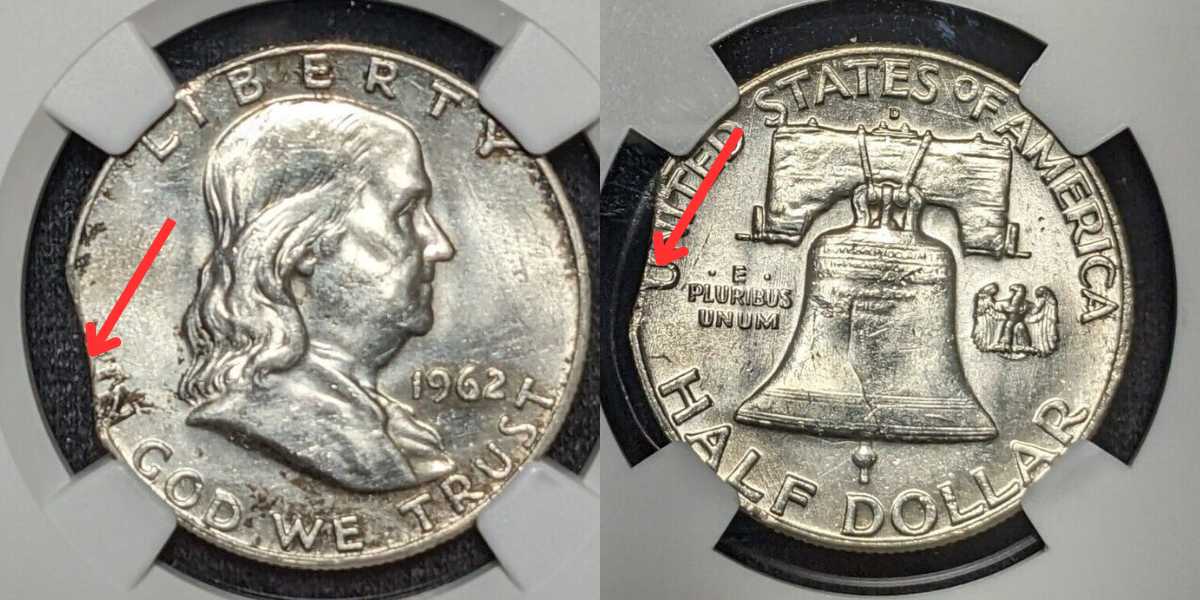
This type of error happens when part of a coin’s blank planchet is missing or “clipped” due to an issue with the cutting machinery in the min —this leaves the finished coin with an irregular or lobed shape.
Even though this coin’s graded at MS62, it is selling for $195 courtesy of its distinctive clipped shape.
1962 Franklin Half Dollar RPM D/D Mint Error
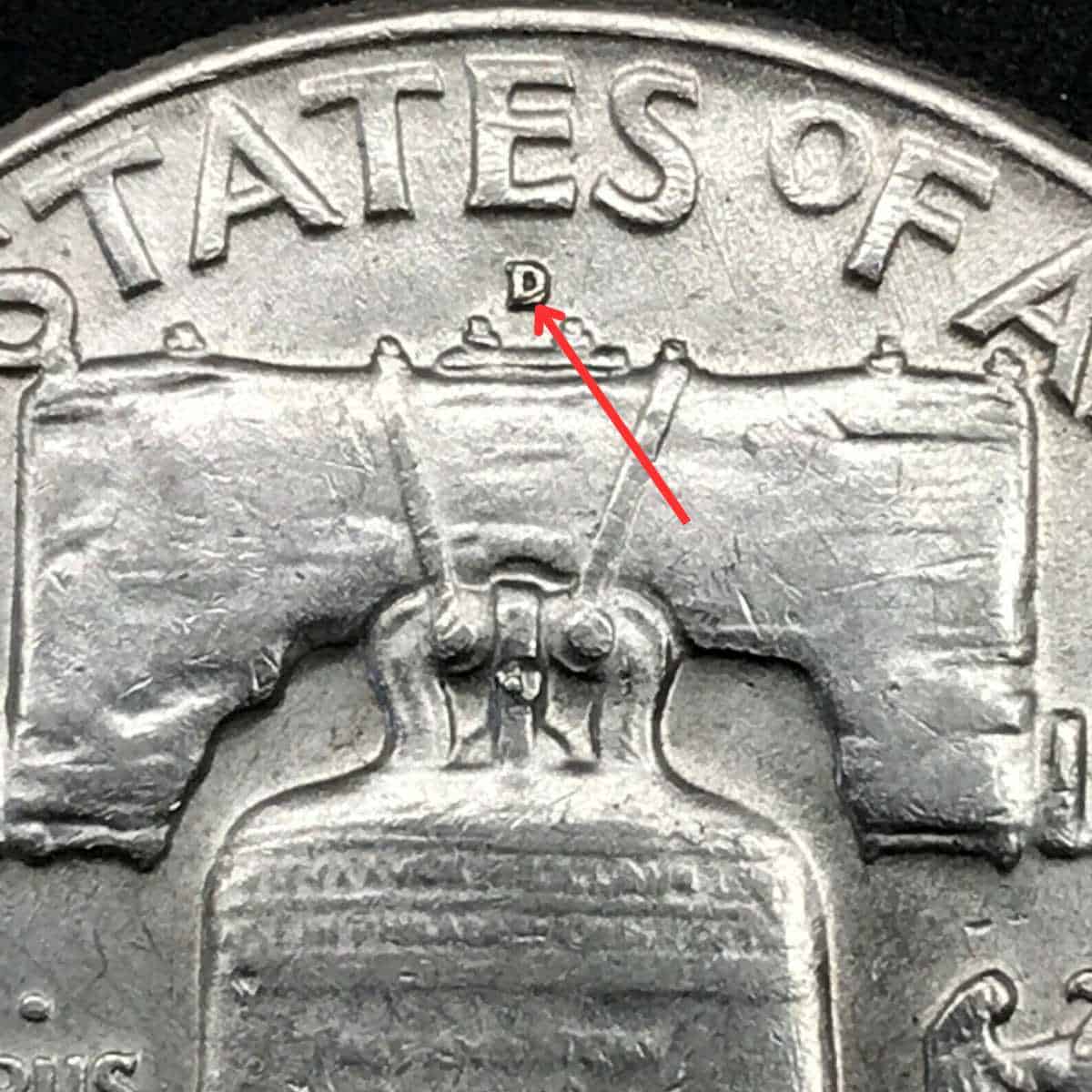
RPM stands for Repunched Mintmark, in this case, a doubled D mintmark. This error occurs when the symbol identifying the mint is stamped more than once in slightly different positions, making the mark look doubled in most cases.
This 1962-D 50C piece doesn’t have a formal grade, yet it commands nearly $30 due to its re-punched mint mark.
1962 D Half Dollar Obverse Planchet Lamination Mint Error

Sometimes flaws exist in the blank planchets themselves before being stamped. One such error is a thin, laminated layer or inclusion under the coin’s surface.
Listed at only $29.99, this 1962 half dollar exhibits a clear obverse lamination that peeks through Franklin’s portrait.
1962 D Franklin Half Dollar Nice Toning
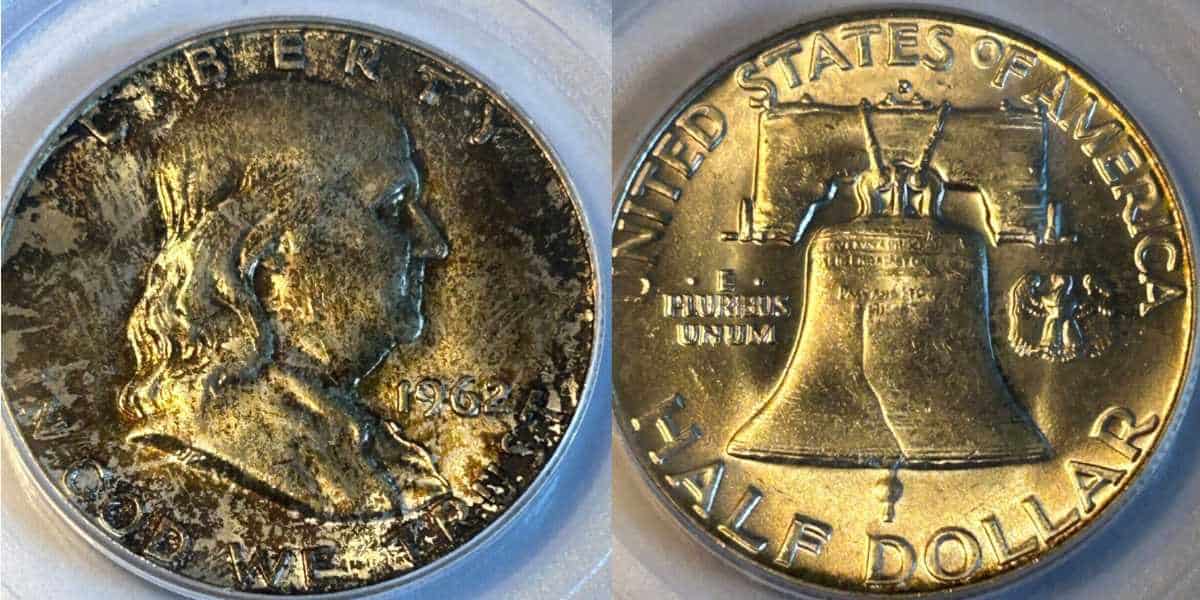
Finally, while not technically an error, some coins develop pleasing toning or discoloration over time due to their metal composition. Due to their reactive metal mix, Franklin half dollars are especially prone to toning shifts.
Graded modestly at MS64, this toned example still draws $39 thanks to its attractive iridescent hues gained through natural aging.
Conclusion
It’s often said that it’s not how you start but how you finish that really matters. The story of these nostalgic, shiny Franklin half dollars from 1962 took surprising turns.
Getting one professionally graded can make a big difference in its value. Sometimes, all it takes is a single higher grade, a color change, or an error from the mint to bum up the value quite a bit: from a two to five-figure valuation.


Jenson is a professional numismatist, a dedicated coin collector, a graduate of the College of Business at Oregon State, a life member of the American Numismatic Association (ANA), and an overall coin nerd. He is the founder of Coin Value List.
